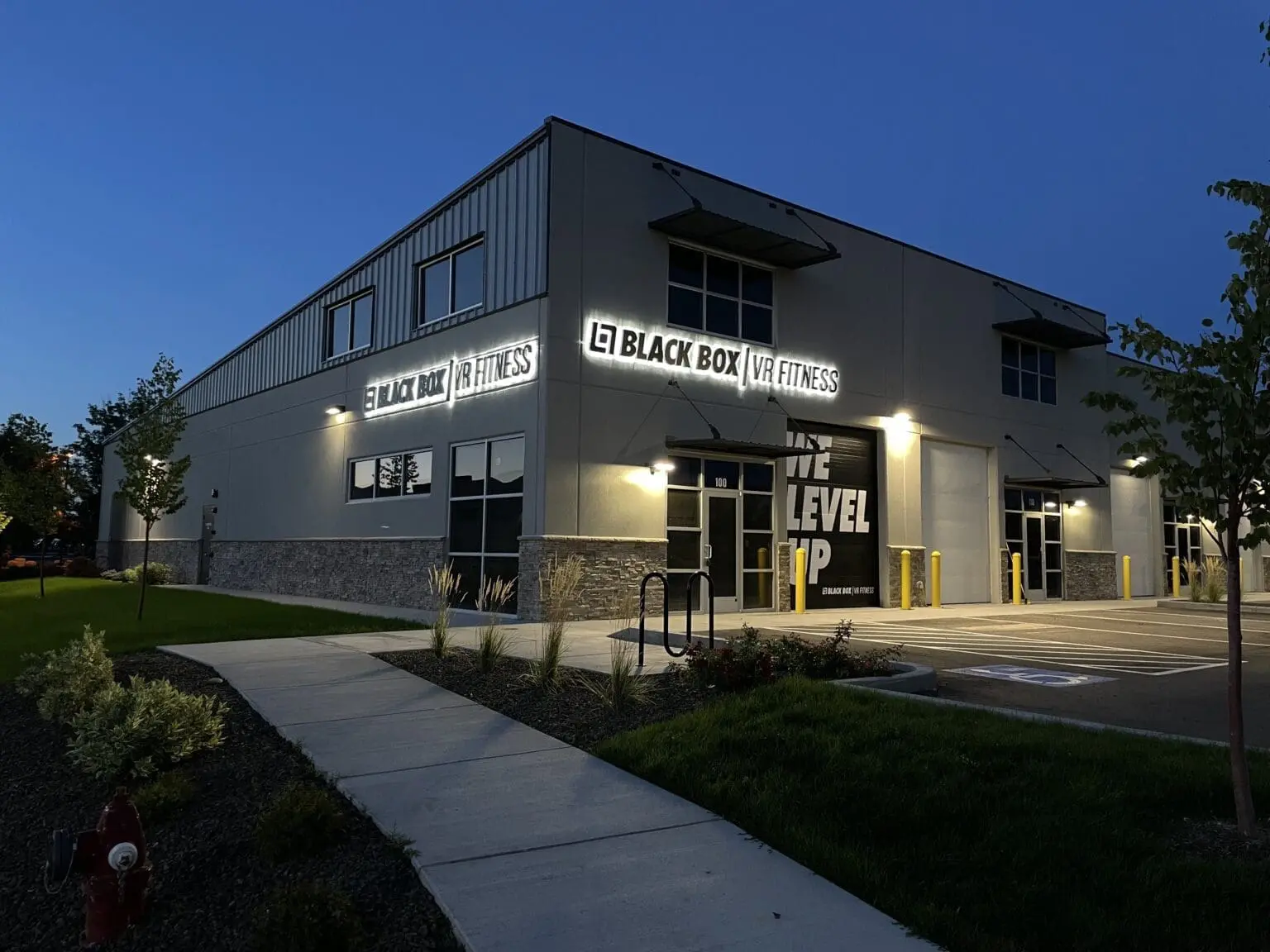UCLA studies found that our workouts beat traditional exercise programs in fitness and body transforming results. It’s not just fun; it’s a scientifically proven.

”Leave behind the boring workouts of the past and step into a future where exercise is thrilling!
Your goals are within reach, and Black Box VR is the key to unlocking them. See how in this video:
WHY DO SO MANY PEOPLE CHOOSE BLACK BOX VR?
Science-Backed Superiority
Revolutionary Fusion of VR and Fitness
Merge the thrill of gaming with the benefits of intense workouts for motivation that never ends. Finally.
AI Guided Fitness Journeys
Imagine a fitness program that evolves with you, crafted to your specific needs and goals. We offer a personalized experience guided by advanced AI.
Transform Your Whole Life
Beyond physical gains, members report massive improvements in mental clarity, sleep, emotional well-being, and life satisfaction. Your entire life will improve!
”“THE MAGIC LIES IN THE FUSION OF CUTTING-EDGE VIRTUAL REALITY AND AI. THIS EXPERIENCE TRIGGERS A CASCADE OF DOPAMINE AND ENDORPHINS, SIMILAR TO A PERFORMANCE-ENHANCING DRUG, BUT COMPLETELY NATURAL.”
Ryan DeLucaCEO of Black Box VR and Founder of Bodybuilding.com

HOW IS THE GAME PLAYED?
This is no gimmicky, one-dimensional fitness game. Millions of dollars of development have gone into using the most effective gaming mechanics and behavioral psychology to create an experience you’ll itch to come back to over and over.
30 MINUTE EPIC BATTLES
Your mission: Destroy their Crystal before they destroy yours!
- You are in a huge stadium with a battlefield.
- Break through gates to be able to attack the Crystal.
- Gates are worth 500 points.
- Destroy the Crystal and get 1000 points!
- Who can get the most points in 30 minutes?
EXERCISES = YOUR WEAPONS
Every exercise rep fires a different, powerful attack in the game. Including:
- Chest Press: Fire Beam
- Overhead Press: Meteor Strike
- Squat: Ice Shard
- Deadlift: Cold Fusion
- Lat Pulldown: Wind Blast
- Row: Lightning Strike
DEPLOY YOUR CHAMPIONS
Build and upgrade your Champion team! Each one has unique abilities, strengths, and weaknesses, including:
- Tanks: Absorbing damage with their high health
- Archers: Striking from a distance
- Melee: Fighting in close combat
- Flying: Wreaking havoc from above
- And many more!
ALL THE FEATURES, ALL THE FUN
POWERUPS
Turn the tide of battle with game-changers like Hypnosis, Invisibility, Grenade, and more!
TOWERS
Unlock special exercises like bicep curl and tricep pushdown to construct powerful Towers!
SIDEKICKS
Your sidekick can be called in once per battle with devastating results. Don’t waste it!
MINIONS
They are small but mighty and spawn automatically every ten seconds. Upgrade them by maintaining your workout streak!
MORE!
Boss battles, leagues, co-op mode, cosmetics, IRL rewards, and so much more. It’s insane.
Learn more about the game!
THE WORLD’S MOST ADVANCED EXERCISE MACHINE
This technical marvel delivers a full-body workout in VR, automatically configures for each exercise, adapts to your fitness level in real-time using advanced AI, remembers everything you’ve ever done, and maximizes your fitness results.
This Is Real Resistance for Real Strength Training!
Our ElectroForce Drive system delivers REAL weight resistance. Your body is constantly challenged in the best way possible, leading to superior fitness results.
- No need to manually change weights—resistance is set automatically!
- Adjustable from 5 lbs to a whopping 250 lbs.
Your Own Private Booth!
You get your own enclosed booth for the entire workout! No sharing, nobody gawking, and no worrying about somebody hogging the equipment you need.
”“GYMS HAVEN'T CHANGED IN 75 YEARS. THE OLD WAYS FAILED US. WELCOME TO A NEW ERA OF FITNESS!”
Ryan DeLucaCEO of Black Box VR

3 Minute Video
Your First Experience: What To Expect?
PLAY THE GAME 3 TIMES PER WEEK FOR 90 DAYS AND WE GUARANTEE RESULTS
UCLA STUDY: "BETTER RESULTS THAN TRADITIONAL GYMS"
The 2022 UCLA peer-reviewed study on Black Box VR found several advantages over traditional gym exercise:
GREATER MUSCLE AND STRENGTH GAINS: The Black Box VR group experienced significantly greater improvements in muscle size, strength, and endurance.
MORE FAT LOSS: Black Box VR users showed more fat loss compared to traditional exercise.
IMPROVED CARDIO FITNESS: There were significant enhancements in HRV and blood pressure.
LESS TIME REQUIRED: Black Box VR workouts were shorter (30 minutes vs. 65 minutes), yet yielded better results.
MORE FUN AND ENGAGING: The gamified nature of Black Box VR workouts made exercise more engaging, less monotonous, and easier to adhere to.

”You're not just working out; you're building a foundation for a life brimming with endless possibilities. Commit today for a better tomorrow.
Your future self will thank you, not just for how you look, but for how you feel.
WHO IS BLACK BOX VR FOR?
Black Box VR isn’t just another gym, it’s a fitness revolution for everyone.
Fitness Newbies
Feeling intimidated by normal gyms? Black Box VR changes everything! No experience needed. Our intuitive VR experience guides you through workouts in your own private booth without judgment. Feel stronger and more confident after just one session.
Serious Athletes
Craving a fresh challenge? Black Box VR delivers high-intensity gamified workouts that test your strength, endurance, and agility while tracking progress. Compete with friends and crush fitness goals in an immersive environment.
Busy Professionals And Parents
Juggling a busy life? Our efficient 30-minute workouts deliver maximum results in minimal time. Fit Black Box VR into your schedule with flexible session times and no extra equipment needed. Leave energized and ready to tackle your day.
Those Needing Motivation
Staying motivated with fitness is tough! We help you escape gym boredom with fun new challenges! Track progress, team up with friends, and unlock new levels that keep you engaged long-term. Our supportive community provides extra encouragement to stay on track.
”It's not just more fun. Black Box VR actually gives you better results than normal gym workouts!
Remember those nights you laid in bed, wondering why you couldn't stick to a fitness routine? Those nights are behind you.
YOUR QUESTIONS: ANSWERED
New! Get your detailed questions answered by MAIA, our AI chatbot!
I'm new to VR. Will I get motion sick? Is it user-friendly?
You will NOT get nauseous! Black Box VR is designed with comfort and user-friendliness in mind, making it accessible and easy to use, regardless of your experience with VR. Our technology was designed to ELIMINATE any chance of motion sickness. Even people that are super susceptible to it have reported zero dizziness or nausea. Come try it!
Can Black Box VR accommodate my fitness level?
Yes, Black Box VR is perfect for all fitness levels. Whether you’re just starting your fitness journey or you’re a seasoned gym enthusiast, our program is tailored to your individual fitness level. It adapts to your capabilities and progressively challenges you as you improve, ensuring that your workouts are always both manageable and effective.
I have a busy schedule. How time-consuming are Black Box VR workouts?
One of the great advantages of Black Box VR is the efficiency of the workouts. Our sessions are designed to deliver a comprehensive full-body workout in a shorter time frame compared to traditional gym sessions. Each workout is only 30 minutes long! This means you can achieve significant fitness results even with a tight schedule, making it a practical option for those with busy lifestyles.

Our community has completed over 150,000 workouts in VR! The addiction is real.
Collective Reps
22,731,373
Collective Sets
1,588,081
Collective Lbs. Lifted
2,204,833,226
Member Story: "This game has changed my life."
"Black Box VR has completely changed my life. Just by playing a fun and exciting game, I've leveled up my body and mind. I'm forever grateful." - Dakota Gullickson, Meridian, Idaho
-45
Pounds
+214%
Strength
WE LEVEL UP·
WE LEVEL UP·
WE LEVEL UP·
WE LEVEL UP·
WE LEVEL UP·
HOW WE CREATE THE CLEANEST AND MOST HYGIENIC WORKOUT ENVIRONMENT
- YOUR OWN VR FACE PAD: Every member gets their own face pad which attaches to the headset. See video!
- MEDICAL-GRADE SANITIZATION: The headsets are cleaned between uses with Clean Box technology using UV-C light, a medical-grade process trusted by hospitals.
- NO DIRECT SWEAT CONTACT: The design ensures that your face will never touch another person’s sweat!
“I worried about sharing headsets, but with your own personal face pad, it’s like you get your very own headset. And the way they sanitize the headsets is really fantastic. It’s more hygienic than a regular gym!” – Cheryl T., Lost 17 Lbs.

MEMBERSHIPS YOU CAN EASILY AFFORD
Cancel anytime. Sign a 12-month commitment to your fitness goals and get 15% off!
Lowest Cost
Off-Peak
Save money by limiting your workouts to times when the gym is less busy. Great for people with flexible schedules!
3x Per Week: $99.99 / mo
Unlimited: $139.99 / mo
Most Popular!
Regular
Join our community and get more fit than you ever imagined. Get full access and schedule up to 3 days in advance.
3x Per Week: $159.99 / mo
Unlimited: $199.99 / mo
Extra Perks
VIP
Book workouts up to 7 days in advance, helping you get the times you need. And more perks and rewards!
3x Per Week: $209.99 / mo
Unlimited: $249.99 / mo
Exclusive
Elite
Elite status! Schedule workouts up to 4 weeks in advance to get the times you want, along with many other perks. Only 10 Elite Memberships available.
Unlimited: $349.99 / mo
It's Your Move
There is no catch. We know you will love it.
View Gym Locations And Start Trial NowThis offer expires soon or when gym capacity is reached.


